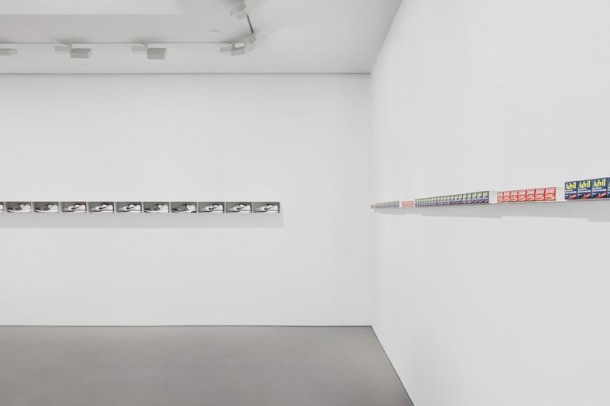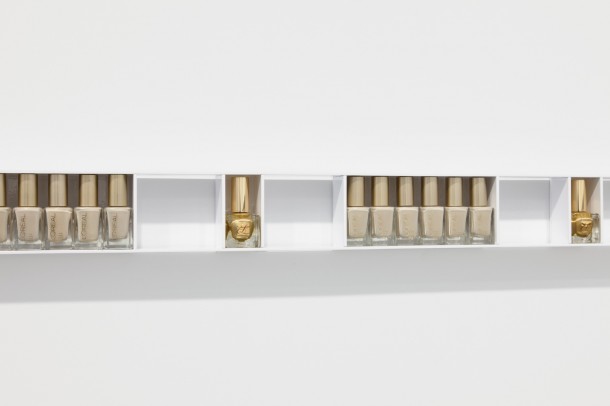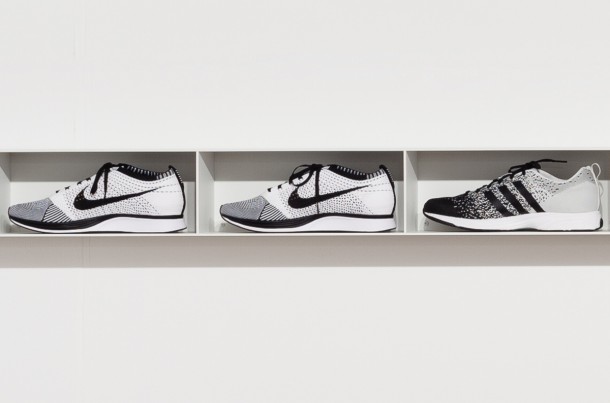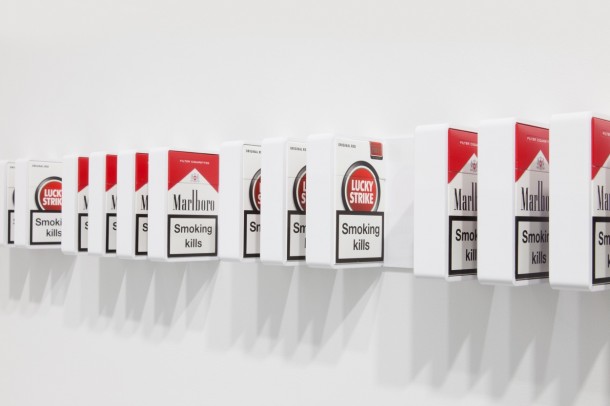MICHAEL WANG: RIVALS
| January 12, 2015
WEB EXCLUSIVE

Courtesy of Andrea Rosen Gallery in collaboration with Foxy Production.
“RIVALS” is a savvy interrogation of complicity in a hyper-capitalist era: a time in which artworks are being treated like commodities as never before, resulting in the repetition of certain styles and tropes seemingly repeated ad nauseam. This is cannily reflected in this exhibition through the pairing of consumer products taken from the portfolios of rival companies with telling similarities: a reflection on how consumer goods essentially rely on marketing and branding to assert difference . Wang negotiates this trend through the presentation of five white metal shelves jutting out from the walls of the white cube at eye level, like contemporary Donald Judd stacks. Each shelf features products taken from the portfolios of rival firms combined into a single artwork. In the case of LRLCYEL (2014), for example, five compartments each contain six beige bottles of L’Oreal nail polish, separated by four compartments that each contain a single bottle of Estee Lauder nail polish in gold. In NKEADDYY (2013), a shelf is divided into 13 compartments of equal size, with three groups of three Nike trainers broken up by two groups of two Adidas set between them.

Courtesy of the artist

Courtesy of the artist
The title of each work reflects the products that go into the composition: NKEADDYY is Nike and Adidas, PFEJNJ is Pfizer and Johnson & Johnson (Advil and Tylenol, respectively), and PMBTI stands for Philip Morris International and British American Tobacco (Marlboro with Lucky Strike). But the merger does not end there: each work comes with a certificate, all of which are presented together at the entrance to the gallery in a single display case. Each certificate shows the two brand names included in the work and the name of the merged product. Then, at the bottom of the certificate, we are told, in fine print, that every sculpture represents one-millionth-of-one-percent ownership in a hypothetical merger of the two firms, as well as the number of shares in each company that would be required to produce such a stake. For LRLCYEL it is stated as: “30 Shares LRLCY-OTC / 3.0 B Shares Outstanding 4 Shares EL-NYSE / 0.4B Shares Outstanding.” In each case, the shareholder is listed as Michael Wang—the idea being that the sale of each sculpture, in fact composed according to the number of shares required to produce the merger articulated on the certificates, will fund the necessary investment to produce the desired one-millionth-of-one-percent stock share in each firm. Wang thus becomes the fractional owner of a conceptual merger through the sale of actual consumer products, completing a cycle of mediation in which the sculptures represent both object and transaction, and the artist is as much an investor as the collector who purchases his art.

Courtesy of the artist
In this, though Wang takes capitalism and circulation as his subject, he pushes his response beyond simple representation and critique. He does this by considering how rival firms often benefit from direct competition not only because their rivalry forces—or encourages, depending on how you look at it—growth, change, and adaptability, but because such rivalries often create greater market shares by stamping out weaker competitors, thus leaving a handful of companies to dominate the field. Yet, this only provides the backdrop to Wang’s main point: that individuals impact the value of publicly traded companies by investing in their products or in their stock. Wang demonstrates not only the codependence—or even the dialectics—of artist and collector, but also the power of direct competition and the very method with which to transcend it, since it is individuals who ultimately drive value, whether monetary or symbolic.
Michael Wang: “RIVALS” is at Andrea Rosen Gallery 2, New York,
from December 13, 2014 – January 24, 2015

